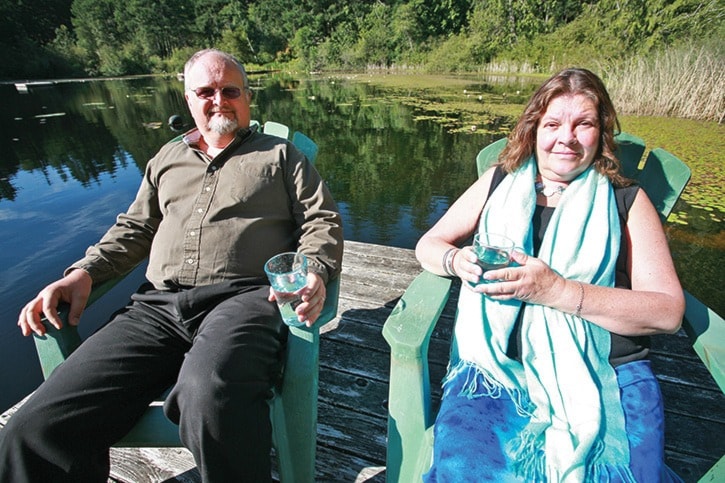Residents living in the picturesque forest surrounding Teanook Lake are starting to worry about the future of their drinking water.
Contaminated soil from the Esquimalt Graving Dock Waterlot started being dumped at Highlands Highwest Landfill on June 17.
The landfill is about two kilometres from the homes of concerned residents Neville Grigg and Darlene Sanderson.
“This contaminated waste is really scary waste,” said Grigg.
Both Highlands residents live on Teanook Lake which provides their household water.
Grigg’s home has a water filtration system using sand and ultra violet rays. If the chemicals from Highwest Landfill make their way into Teanook Lake he is unsure if the system would filter out the toxins.
“We shouldn’t be messing with this stuff,” he said.
“The whole aquifer is at risk of being poisonous,” Sanderson said, adding more than 90 per cent of Highland residents are dependent on groundwater.
Living so close to the landfill Grigg is upset he only heard about the Esquimalt Graving Dock remediation project days before the work began.
“There was no public consultation and no warning,” he said.
The recent flood disaster in Calgary also has Grigg concerned about possible disasters and leaching of the toxins.
“If there is a big flood here, immediately adjacent to the landfill is Teanook Creek which feeds into Thetis Lake,” Grigg said.
Sanderson and Grigg, along with a small group of residents are asking for the work to stop until a third party, independent environmental and healthy impact study, a disaster risk assessment and a ground water study be completed.
“This isn’t just an environmental issue, it’s a health issue,” Sanderson said.
Sanderson was alarmed when a neighbour told her some sediment was disposed of incorrectly.
On July 20, contaminated soil from the Esquimalt Graving Dock waterlot was deposited in an unlined cell at Highwest Landfill on Millstream Road.
“It was an error. We’ve started to scrape and remove all the soil from the cell,” said Andrew Rodych, strategy issue and policy advisor for Tervita. The work was expected to be complete by July 26. Only a portion of the load was dumped in the cell.
Tervita has completed six soil tests to ensure environmental safety.
The contaminated soil is only to be discarded in cells lined with plastic to prevent leaching.
To ensure it doesn’t happen again, Tervita plans to line every cell at Highwest Landfill by Aug. 3.
“This isn’t hazardous waste,” Rodych said. “It just doesn’t have levels of normal soil. It has higher levels of salt and sodium, but it’s not as hazardous as uranium.”
“Waste will be transported to the Highwest landfill in trucks that have sealed end gates, so material will not leave the truck. As another level of assurance, additional vehicles will occasionally follow the loads to ensure nothing is leaving the truck. The drivers of the trucks have extensive experience with waste transportation and will act with the safety of the community and environment top of mind,” said Stacie Dley, Tervita communications advisor, in a previous interview.
The sediments are considered contaminated, but not hazardous as defined by the B.C. Hazardous Waste Regulation.
Even though the contaminated sediments are being stored in the Highlands landfill, it’s out of the municipal council’s jurisdiction and is being overseen by both the provincial and federal governments.
Highlands council requested the federal government fund an independent, professional third-party assessment of the landfill’s design and monitoring systems.
“We are doing this both for public health and for the environmental protections to be assured,” said Mayor Jane Mendum.
The district is in negotiations with the federal government and looking into other options to have the study complete as soon as possible.
“All of the regulations in place (for Highwest Landfill) must be satisfied. The provincial regulations are all based on law,” Mendum said. “Of all sites in Highlands this one has the most oversight and it cannot be breached.”
Starting in June and continuing until March 2014, 150,000 cubic metres of contaminated sediment will make its way to the Highlands landfill.
Public Works and Government Services Canada directed all News Gazette questions to Tervita.
